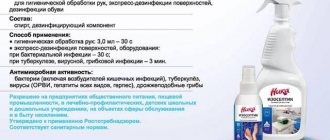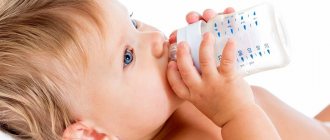Contents of the article:
- First aid at home
- When should you see a doctor?
- Prevention measures
- What should you not do if you have a lip injury?
Even the calmest child cannot grow up without bruises, abrasions and scratches. Fortunately, most injuries are not too severe and do not require medical attention. But it is necessary to relieve pain, stop bleeding and treat wounds with disinfectants very often. Parents must be able to do this, so they need to know the rules of first aid and have the most necessary medications in their home medicine cabinet. Often, when a child falls or hits an object, his chin, lips or nose are damaged. If the lips are injured, then, as a rule, there is bleeding - there are many blood vessels in this place, and the skin is thin and delicate. Of course, it’s scary for the baby, but blood is a natural disinfectant that washes away dirt from the wound. We will tell you in this article what you should and should not do if your child has a broken lip.
A child has a broken lip: first aid
How to help a child if he has a broken lip? If an incident occurs in front of the parents, at first they themselves are scared, not knowing how serious it is. Seeing blood on the baby's face, mothers often panic and get lost. How should you act in this situation?
- If an accident occurs, parents first need to calm down themselves and reassure the child: he is scared, in pain and he is waiting for help.
- If everything happened on the street, you must blot the wound with a clean handkerchief or a bactericidal napkin. As a rule, mothers of small children have such means with them.
- After the bleeding has stopped, you need to carefully examine the wound and decide whether there is a reason to see a doctor or whether it is enough to provide help on your own. If, in the opinion of the parents, medical intervention is not required, you need to return home and treat the wound.
- Before the procedure, you should wash your hands well and treat them with an antiseptic. You should also wash your child's face and hands with warm running water.
- The child needs to treat the wound with some kind of disinfectant to prevent infection from entering and spreading. To do this, use a solution of potassium permanganate (the color of the solution should be pink) or 3% hydrogen peroxide. To treat, wet a swab with one of these products and apply it to the sore spot for a few seconds.
- To further disinfect the oral cavity, older children can rinse their mouths with Miramistin or chamomile decoction; very young children can treat the wound with a cotton pad soaked in medicine.
- After the bleeding has stopped, you need to carefully examine the injury - as a rule, swelling appears. It can be relieved with cold compresses, which also stop the bleeding and soothe the pain a little. For a compress, put ice in a plastic bag, wrap it in a napkin made of natural fabric and apply it to the lip. If you don't have ice, you can cool a metal spoon or other small object and also apply it to the sore spot. Read what to do if a child has a nosebleed in another article on our website.
The wound must be examined and treated for several more days after the injury, until complete healing:
- for a quick recovery, it is recommended to apply ointments several times a day: zinc, calendula, Bepanten or Solcoseryl;
- make sure that the child does not try to tear off the crust that forms during the healing process;
- for 3-4 days, treat the wound with a solution of furatsilin, moistening a swab and applying it to the sore spot, periodically spray with Miramistin for disinfection;
- several times a day, lubricate the bruise site with protective and softening agents, especially before going outside, you can use baby lipstick or propolis ointment.
If it is not possible to use medications to treat the wound, you can also use folk remedies that have long been used for these purposes as additional ones:
- natural honey or propolis is used to treat wounds;
- Sea buckthorn oil is used for faster healing;
- use a decoction of chamomile, which has disinfectant properties.
What can you do to prevent the risk of lip injury?
As you know, a child is not immune from bruises and cuts, but the following preventive measures will help reduce the number of injuries:
- Parents must explain to the child what to watch out for on the street, how to behave on the playground, how to use swings, carousels and other attractions.
- The child should wear comfortable shoes with secure fasteners and elastic, non-slip soles.
- There should be no parts on the baby's clothes that could get caught on any surrounding objects.
- When skiing, biking, or skateboarding, you should wear knee pads, helmets and other protective equipment.
- Do not leave children unattended.
- At home, make sure that the child does not climb onto the windowsill when the window is open, and do not leave sharp objects in a visible place.
- The child must be transported in a child seat in the car.
- Have first aid supplies at home.
It's hard to see your baby crying and with a broken face. But if this has happened, there is no need to despair. Good disinfectants and wound healing agents, a healthy child’s body and, if required, qualified medical assistance will help to quickly cope with the consequences.
When to see a doctor
As mentioned, if the wound is shallow, then it can be treated at home. But at the same time, parents should carefully monitor the child’s condition in order to seek medical help if necessary.
You should immediately visit a doctor after a cut lip in the following cases:
- The wound is too deep or the inner surface of the lip is damaged;
- Not only the lip is damaged, but also the gum, tooth or frenulum. In such cases, you need to contact a dentist who will assess the consequences of the injury and prescribe the necessary treatment;
- The body temperature increased to 37.5°C or more within 2 days after the lip cut. Heat indicates infection of the damaged area;
- Blood continues to flow from the wound for half an hour;
- There are suspicions that there is a foreign body in the wound;
- The injured lip is numb;
- The swelling and redness does not go away for a long time.
If such symptoms appear, immediately go to the doctor, as your child’s health is at risk!
Possible misconceptions and complications
Any damage to the face seriously spoils the appearance and attracts unnecessary attention, so all victims are concerned about how long it takes for a cut lip to heal. If there is no inflammation, then after a few days you will notice a significant improvement. The exact timing depends on the severity of the damage.
Getting an infection into the wound aggravates the problem. The inflammatory process begins, the rupture can “turn out”. Redness of surrounding tissues and swelling, accumulation of purulent exudate - if all of the above symptoms are observed, the doctor will prescribe appropriate medications. However, fibrin plaque is taken as a sign of inflammation, which should not be peeled off or washed.
Caring for the wound is actually very simple. You need to try not to disturb the fresh seam, and Levomekol ointment, which has weak antibacterial properties, is perfect for softening. It is not worth drying with alcohol solutions; they can provoke the formation of a rough scab, which, contrary to common misconceptions, does not contribute to a quick recovery.
Prevention
Of course, every mother would like her child to do without injuries. Unfortunately, this cannot be completely avoided, since children are very active and this period is rarely without minor troubles. The only thing I can recommend here is:
- have a conversation with your child about safety rules;
- stock up on the necessary funds to provide assistance in a timely manner;
- be patient and remain calm under all circumstances.
Now, no matter what happens: the child hits or falls with subsequent injuries, you know perfectly well what to do and can help your baby get back to playing.
If a child breaks his lip, what should parents do?
0.0Rating
Visitor rating: (0 Votes)
Children's curiosity and activity do not always play into their hands. Indeed, due to inaccurate coordination of movements and excessive curiosity, various injuries occur. Most often the face is exposed to them. Therefore, situations where a child breaks his lip occur quite often. How to help a young restless person in this situation, and what actions need to be taken first - you will learn about this from this material.
What are the dangers of a split lip?
Human lips contain a large number of small capillaries. Therefore, when any scratch occurs, serious bleeding occurs. This is a very unpleasant sight, so blood scares mothers. However, its excessive course is a normal reaction. Therefore, it is necessary to eliminate panic and provide first aid to the baby. If you ignore this advice, unpleasant consequences may occur.
- The beginning of the inflammatory process on the lip and inside the oral cavity;
- development of more serious skin diseases in the baby;
- serious infection getting inside the wound;
- the occurrence of serious pain.
To know how to act in this situation, you need to consider several points and rules.
Treatment for a split lip
If a child has a broken lip, you need to pay attention to several recommendations in order to provide him with help quickly and efficiently
It is important to act calmly, clearly and confidently, without being frightened by the sight of a bleeding wound; washing the broken lip is the next step; to carry it out, you need to thoroughly rinse the wound, asking the child to open his mouth; after this comes the moment of disinfection, you can use hydrogen peroxide, manganese solution; look at the size parameters of the damage: a small wound can be dealt with at home, but a large injury will require stitches; You need to put something cold on the affected area - an ice pack, which will help relieve swelling from the tissue.
So, if a child has a broken lip, these actions will help quickly relieve pain and stop bleeding. Next, you need to choose a good ointment for treatment.
How to lubricate the wound
In all generations, products such as iodine and brilliant green have been widely used, but in this case they will not only not bring any benefit, but can also seriously harm, because the skin of babies in the lip area is delicate and sensitive. But honey can easily be used for first aid. This natural remedy has a wide range of anti-inflammatory properties. Also widely used is an ointment based on a beekeeping product - propolis, zinc ointment applied to damaged skin several times a day, and sea buckthorn oil.
If a child breaks a sponge from the inside
If a child breaks his lip from the inside, you need to do a few simple steps: treat the damage with Miramistin solution using a cotton pad. If the child is older, you should ask him to rinse his mouth on his own. After this you need to apply a special ointment. For this situation, the “Rescuer” balm is well suited. So, if a child breaks his lip, the first thing to do is to calm down and direct all efforts to provide urgent help.
Preventive actions
Every mother wants her child to be able to cope without injury, but since children are active, it is problematic to avoid such consequences. The only thing that can be done in this situation is to have a conversation with the child about compliance with general safety rules, and also prepare means so that qualified assistance is provided in a timely manner. Now you know what to do if your child breaks his lip.
Rating 4.9 Votes: 7
First aid for parents
The lip is a very delicate part of the human body. Under the thin skin of the lips there are a huge number of small capillaries, which even with the slightest injury bleed heavily. A child can break his lip anywhere: he can trip and fall, hit a door frame while running enthusiastically, fight with a peer over a toy, etc. Of course, your own child’s broken lip is not a sight for the faint of heart. But a parent must be able to cope with their emotions, remaining calm and confident. But what should be done if a child has such an injury?
- If a child breaks his lip on the street, the wound should be blotted with a clean bactericidal wipe or a regular handkerchief. Before treating a wound, be sure to wash your and your child’s hands and treat them with an antiseptic to reduce the risk of infection of the wound.
- At home, the wound on the lip should be washed with slightly warm water. If there are grains of sand or particles of earth on the wound, it is important to carefully remove them with a stream of warm water.
- Treat the wound with hydrogen peroxide, even if it is located inside the lip. To do this, soak a cotton swab in a disinfectant and apply it to the damage for a few seconds.
- You can disinfect the oral cavity if the child rinses it with a solution of the drug Miramistin or chamomile infusion. If the baby does not yet know how to do this, apply a cotton pad soaked in one of these products to the wound.
- Instead of antiseptic drugs, you can use natural honey - it copes well with germs and heals small wounds. However, it is better to lubricate the child’s lip with sweet medicine at night so that the baby does not feast on it.
- If you have successfully stopped the bleeding, inspect the injury both inside and out: the lip may look swollen. If so, apply a cold compress to it.
- It is not recommended to use brilliant green and iodine to treat a wound on the lip, since these products can damage the delicate skin of the organ, and iodine will contribute to the resumption of bleeding.
- If your lip is severely broken and you find a fairly deep wound, it is better to rush to the trauma department or call a doctor at home. Your baby may need stitches.
If a child manages to break his lip, do not scold him for his carelessness and clumsiness. Show how much you love your baby, be confident in your actions, don’t panic. Feeling parental support, the baby will quickly calm down, and only a slightly swollen area on the lip will remind of the past injury. And remember: if a child’s temperature rises due to an injury, the frenulum, teeth or gums are severely injured, and the wound is deep or completely through, do not hesitate to visit a doctor - doing it on your own in this case can lead to irreversible consequences.
What to do and how to relieve swelling?
If your lip is swollen for no reason, then you need to provide first aid at home:
- A cloth moistened with cold water is applied to the lip. Keep the compress for at least a quarter of an hour. It will ease the pain and relieve some swelling.
- Make a compress from an aloe leaf. It needs to be cut lengthwise and applied to the sore lip so that it comes into contact with the juice. The substances that aloe contains will help eliminate inflammation and pain. They will relieve swelling of the lips and have a disinfecting effect.
- If your lips are swollen, seemingly for no reason, then a tea bag will remove the inflammation. It is briefly immersed in hot water and allowed to cool, and then applied to the sore spot and held for some time. This compress relieves swelling of the lips and reduces pain.
This is only the first stage, which alleviates the patient’s condition and does not completely eliminate the cause of lip inflammation.
Treatment is prescribed after identifying the culprit of the swelling. A lip that is swollen is treated with an antiseptic, such as hydrogen peroxide.
It is especially important to do this if there are wounds. After this, it is cauterized with iodine
If the affected area remains unchanged and does not dry out, then it is better to seek qualified help from a doctor.
1. If you have an allergy, you need to find out the cause of the reaction and eliminate it. Then take an antihistamine, which is prescribed by a specialist. For allergies, medications such as Suprastin, Diazolin or Claritin are used.
2. In case of inflammation caused by a dental error, it is better to entrust the treatment of the problem to a qualified dentist. Since the lesion is located inside the oral cavity, you cannot do anything on your own. Inflammation, which is accompanied by an accumulation of pus in the swollen upper lip, is especially dangerous. After all, it can enter the brain. This can be fatal. With periostitis, ointments and rinses will not help, since pus accumulates inside the jaw or periosteum.
3. Trauma, bruise of the upper lip due to a blow is often accompanied by the development of a bruise, a hematoma occurs. In order to prevent it, make a compress from ice cubes wrapped in a napkin from the freezer. Apply to lips for 15 minutes. Do not hold ice for long. At the same time, it must be wrapped in something to prevent hypothermia.
4. Alternatively, apply a bottle of cold water to the swollen lip. The procedure is repeated several times until the swelling subsides. In this case, a bruise can be avoided.
5. You can buy badyagu at the pharmacy. It is used for hematomas and bruises on the face and body. If it is a powder, then it is diluted with water. A ready-made gel-like mass is also sold. It is applied in the form of compresses to the affected area, and after some time the swelling on the lower and upper lips will subside, and their size will normalize. Antiseptic agents are applied to the affected area several times a day for the purpose of disinfection. Such drugs include Actovegin, Chlorhexidine, Miramistin. At home, use essential oils, such as tea tree. After treating the wounds, apply a bactericidal patch.
6. If the cause of inflammation is a cosmetic effect, such as tattooing, then most likely the swelling is caused by non-compliance with the recommendations of a lip care specialist. At first, you will have to refrain from eating and smoking to prevent infection from entering the wound. After the tissues are restored, it will be possible to lead a normal lifestyle.
7. But if the inflammation does not go away, then a bacterial infection occurs. It is possible that a herpes virus or fungus was introduced during the procedure. In this case, you should consult a doctor so that he can prescribe the appropriate medication.
In any case, if the lip simply swells, it is advisable to provide the patient with first aid. And before starting treatment, be sure to find out the cause of lip swelling. It is best to contact a specialist for this.
Many people face the problem of a split lip. This can happen after a fall or blow. Often, not only a hematoma appears at the site of a bruise, but swelling also occurs. Many people would immediately like to know what to do if they have a broken lip in order to get rid of the swelling.
Note that a bruise can cause many serious consequences if help is not provided in time.
Not Recommended Actions
What not to do if a child has a cut lip:
- Use alcohol solutions. Some parents, even knowing the rules of first aid after a cut lip, use alcohol solutions to speed up wound healing. However, they do not know what the consequences may be after such actions. If you do make this mistake, then urgently treat the damaged area with anti-burn products;
- Use iodine or its derivatives (Betadine) or brilliant green to treat the wound. Many parents are not familiar with the rules of first aid after a cut lip, so they use medications that can harm the child. For example, iodine or its derivatives (Betadine) or brilliant green are often used to disinfect a wound. These solutions, even in minimal concentrations, can damage the delicate skin of the lips and cause chemical burns. In addition, after treating the lips with brilliant green or iodine, a scar may remain on the damaged area;
- Apply ice without a protective coating. Other moms and dads apply ice without a protective coating, which can cause additional tissue damage or hypothermia. The ice must be wrapped in a cloth and kept for no longer than 15 minutes;
- Touch the wound with unwashed hands. Many parents panic so much at the sight of a child with blood on his lips that they completely forget to wash their hands before treating the wound. Then the risk of infection in the damaged area increases, especially if the wound is located on the inner surface of the lip.
How to treat a split lip
If the wound needs to be sutured, then it is better not to argue with the doctor on this issue. The fact is that due to the specific location of the injury, healing can be seriously complicated, and it is better to put stitches. As a rule, it is not possible to bring the edges of the wound closer together with a plaster on the lip.
It is better to wash a broken lip with chlorhexidine. Hydrogen peroxide can be used if there is contamination in the wound, in which case the internal tissue may turn white. This is not pus; you should not try to remove the white inclusions formed due to the initial treatment. Zelenka, iodine, and any alcohol solutions are strictly contraindicated; do not aggravate the damage with a burn.
At first, you can cover fresh stitches with a sterile gauze pad and secure them with a band-aid, but in most cases this is not required.
The child tore the frenulum on the upper lip
The mouth has 2 frenulums that connect the upper and lower lips to the oral cavity. If a child falls and breaks this jumper, then he needs help:
- The mouth is washed with cooled boiled water;
- Then the affected area is treated with hydrogen peroxide;
- After this, the wound is treated with antiseptics: Furacilin solution, Chlorophyllipt oil, Miramistin spray;
- A cold compress is applied to the affected area to help relieve pain and stop bleeding.
After this, you need to urgently show the child to the doctor. This is a serious injury that requires qualified medical care.
Otherwise, the risk of infection increases. If the frenulum does not heal properly, speech defects, facial deformities, and problems with chewing may appear. To avoid complications, you need to put self-absorbing sutures on it.
The operation is performed under local anesthesia for 30 minutes. After it, swelling appears, which with proper care will disappear after 2 days. Tissue regeneration in this area usually occurs quite quickly. You need to take care of sutures after surgery using antimicrobial agents. In addition, it is necessary to rinse your mouth with antiseptic solutions after each meal.
Possible complications
The most unpleasant consequence of a lip cut is infection of the damaged area. As the inflammatory process develops, the edges of the wound seem to turn inside out. The surrounding tissues turn red, swell, and purulent exudate begins to accumulate at the bottom of the wound. When such symptoms appear, medications with antibacterial action are used.
In this case, you need to visit a doctor who will put stitches, then there will be no traces left. If the frenulum of the lip is damaged, and the operation was not performed and the mucous membrane was not restored to its normal state, then the likelihood of the following complications increases:
- Speech defects if the injury occurred at an early age;
- Frequent infection of the oral cavity if the tissues have not grown together correctly;
- Disruption of the digestive organs, as the child cannot chew food normally.
To avoid such complications, you need to immediately show your baby to the doctor. A split lip is an unpleasant injury; it is not life-threatening, but if parents act incorrectly, the risk of complications increases. After a lip injury, you should urgently provide first aid to your baby, and then visit a doctor who will assess his condition.
To speed up tissue healing, you need to use antiseptic and antimicrobial agents. However, before using any drugs or traditional recipes, you need to get your doctor's approval.
Victor Systemov - expert of the 1Travmpunkt site
One can only envy the activity and curiosity of young children. While learning about the world around them, children often injure their knees, palms, and fingers. But most often the face suffers: a child, falling to the ground, due to insufficiently developed coordination, does not always have time to put his hands in front of him, which should hold his body at that moment. So it turns out that as a result of a fall, even the most harmless one, the baby’s nose, forehead or lip suffers. As a rule, these injuries are not terrible, but you need to be able to treat them and reduce pain. Therefore, let's try to understand the question, if a child breaks his lip from the inside and it is swollen - what to do in such cases?
My lip is swollen from a blow, what to do at home – Dentistry
A lip bruise is called damage to the soft tissues of the specified area. Such injuries occur frequently due to the thinness and sensitivity of the lip structure. Often this type of damage is observed in children who usually move actively.
ICD 10 code
According to the International Classification of Diseases (ICD 10), lip bruise has code S00.5. According to the classifier, the name of the wound in this case sounds like “Superficial injury of the lip and oral cavity.”
Causes
This type of injury occurs as a result of:
- falls,
- participation in fights, which led to injury to the face and lip area in particular,
- industrial injury,
- collision of a part of the face with a hard object.
Often such an injury occurs in children who, while learning about the world, behave too actively and therefore often hurt themselves.
Manifestations
When the lip is injured, characteristic symptoms appear such as:
- pronounced swelling. The tissues in the lip area swell very quickly, literally before our eyes,
- formation of a seal inside the lips,
- pain, discomfort in the damaged area,
- bleeding if the integrity of the structures has been compromised and there is a wound surface,
- redness of the skin near the injury site.
The swelling may last for several days without changing in severity.
A child often has abrasions near the mouth along with swelling, which is the result of falling face down.
First aid methods
If a child or adult’s lip is swollen after a blow, what should you do? In this case, first aid is to:
- carefully rinse the damaged area,
- wipe the open wound with Miramistin or Chlorhexidine solution to prevent the possibility of infections. If there is a violation of the integrity of the tissues on the inside (in the oral cavity), these products can also be used for disinfection. An external lip injury can also be treated with hydrogen peroxide, but in no case should you use brilliant green or iodine - they can cause a burn,
- Apply a cold compress to prevent widespread swelling. Do not leave the compress on for more than 15 minutes, otherwise tissue frostbite may occur.
Pelvic contusion
If blood continues to flow from the wound, you need to fold a piece of bandage several times and place it between your lip and teeth so that it is absorbed.
Even though such an injury is not serious, the child should still be taken to see a specialist. A fall that causes a lip injury could result in a severe impact resulting in superficial head injuries.
Diagnosis and treatment
In the case of a lip bruise, a visual examination is sufficient to assess the nature and severity of the injury.
It is possible to treat such damage at home. Therapy includes:
- constant treatment of the wound surface on the lip with antiseptics,
- treating the injury site with sea buckthorn oil, zinc ointment, Solcoseryl up to 4 times a day,
- use of mouth rinse solutions if the lip has been broken from the inside. To do this, use chamomile decoction, chlorhexidine solutions, propolis in water,
- external use of Troxevasin ointment. This drug allows you to remove the tumor and eliminate the hematoma.
For severe swelling and bruising, you can use the following remedies:
- applying a fresh cabbage leaf. The raw material is applied to the site of injury, left for several hours, secured with an adhesive plaster,
- lubrication with a mixture of aloe and honey. You need to take a teaspoon of natural honey and mix it with the pulp obtained from fresh aloe leaves. Apply the resulting composition to the hematoma, hold for 15 minutes, then remove, wash the affected area thoroughly,
- use of badyagi gel or powder. This remedy speeds up the healing process several times. In pharmacies such drugs are presented by Lekar, Badyaga Forte.
If the tissue is severely cut, surgery is performed followed by suturing.
Possible complications
Possible complications from a bruise are:
- penetration of infection through the wound surface with subsequent formation of purulent masses. This condition threatens blood poisoning,
- deep damage, which can further cause lip deformation.
How to provide first aid for a bruise
A lip bruise usually does not have serious consequences
However, it is important to properly care for the injury to prevent infection. Also, after damage, you should undergo examinations to exclude the possibility of damage to other structures.
Symptoms of bruise
With bruises, the main symptoms are: bruising, swelling, pain, and in some cases, limitation of movement.
A bruise forms at the site of the injury - this is blood that has leaked from the damaged vessels. If a lot of blood flows out, a limited accumulation of blood - a hematoma - forms at the site of the bruise. The bruising may be minor, in which case the blood saturates the tissue and the bruise takes on an irregular shape; if the damage occurs inside the fascia that covers the muscle, then the bruise takes the shape of the muscle, and if the blood flows into the interfascial space between the muscles, then, most often, the bruise has elongated shape.
Normally, a bruise goes through several stages of development:
1. Formation of a bruise. This is the period when the damage has just been caused and blood is shed into the tissue. At this time, a “purple” bruise is formed.2. Blue-green bruise period. At this time, the destruction of the formed elements of blood, which is poured into the tissue, occurs.3. Green-yellow bruise period. At this time, an enzymatic change occurs in compounds released from the destroyed blood cells, in particular hemoglobin, which is part of red blood cells. 4. Permission period. At this time, complete resorption of the bruise and restoration of body functions may occur. However, other options are possible when calcifications form. In this case, the site of the bruise is limited to a capsule, into the wall of which calcium molecules are gradually embedded, it becomes dense and is no longer able to resolve.
Hemorrhage can occur not only in the tissue, but also in the cavity: in the joints or abdominal cavity, with blows to the stomach. When there is hemorrhage in a joint, there may be a restriction of movement in this joint, it becomes swollen, and upon palpation (palpation with hands) fluctuation is observed (a feeling of fluid movement in the joint).
Bruises also vary depending on the location of the injury. This could be, for example, a head bruise, a bruise to the elbow, knee joints, a chest bruise, a bruise to the right forearm, and others. Bruises also vary in area. And here I remember black Soviet humor: bruises measuring 3, 5 and 10 kopecks were found on the corpse, totaling 4 rubles 18 kopecks. Sometimes bruises can be very extensive, affecting either half of the child’s body or the entire body. This can happen in car accidents or falls from a height. Such bruises are very dangerous, as extensive blood loss occurs and a very large amount of toxins are formed that enter the bloodstream.
What to do with a broken lip and its swelling from the inside: first aid and wound treatment
A split lip is an injury to the soft tissues and mucous membranes of the mouth, which causes a lot of discomfort.
It is important that the consequences of the cut are minimal
Processing agents
A split lip requires mandatory treatment with antiseptic drugs.
The first place is occupied by hydrogen peroxide - a solution for external use of 3%. The medicine is effective when the baby has broken his lip from the inside.
The main advantage is that (unlike iodine and brilliant green) peroxide can be anointed on open wound surfaces and will not cause burn damage to the skin.
The effect of the drug becomes noticeable: bubbles and hissing appear. The disinfection process occurs through the release of atomic oxygen.
It is forbidden to remove dried bandages and compresses so that the healing wound does not begin to fester. Peroxide is not applied to damaged mucous membranes.
Another broad-spectrum agent is chlorhexidine.
Available in the form of a solution, adhesive plaster, gel and cream. The substance disinfects the wound surface and removes pus. The price of the medicine is affordable for everyone.
The antiseptic is intended for healing ruptures and is capable of treating fungal diseases, sexually transmitted infections, and pathologies of the oral cavity.
A modern disinfectant medicine is Miramistin. The main advantage of the drug is the complete absence of side effects. A solution for external use helps damaged areas heal without burning them.
The medicine kills harmful microorganisms, blocking the inflammatory process. Miramistin is used to treat burned skin areas, for candidal and gynecological diseases, and ENT pathologies.
Potassium permanganate solution is a home method for washing festering wounds. You can prepare weak potassium permanganate by adding a few crystals of permanganate to a glass of warm water. The cut should be treated several times a day, diluting a new mixture.
An alternative option is a dry bandage applied to the torn corner of the lip. It is easy to remove and change. The prepared solution can be used for no more than 2 weeks.
Store in a dark glass container at a temperature not exceeding 15 degrees.
Traumeel ointment will help your lip heal - a homeopathic medicine that helps relieve swelling and eliminate inflammation. The product should be applied to the skin in a thin layer 2-3 times a day for 2-3 weeks. You can use gauze bandages.
If the frenulum is torn, Panthenol cream will help. It promotes rapid healing of damaged areas without scar formation. Before applying the medicine, you need to disinfect the wound. The drug has no side effects, with the exception of intolerance to the components. Apply the cream twice a day until the wound surface heals and the swelling and thickening disappear.
How to remove swelling after a blow
The affected lip may darken and swell. The following types of damage to the labial border are distinguished:
- Bruise (can be caused by being hit by an object, resulting in internal swelling). The bruise or hematoma will go away within a few weeks.
- An abrasion is a minor tissue injury that does not need to be stitched.
- The wounds appear when the labial border is bitten or cut. The main symptom is a violation of the integrity of the skin. The wound surface may be damaged through and through.
Treatment provides assistance in restoring normal shape and allows the natural color to return. If the lip is swollen from the inside, lotions based on bee honey are useful. The mass is applied to cotton wool and applied to the lower or upper swollen area for 30 minutes.
It is forbidden to apply warm compresses to the wound; the area will swell and swell even more.
Wound care
In order for the wound surface to heal quickly, proper care is necessary. There are several recommendations:
- The painful area should be treated regularly and treated with recommended remedies.
- You need to be careful not to accidentally tear the scabs near the wound.
- To avoid injury to the labial border, it is recommended to lubricate it with protective agents.
In most cases, the wound will go away on its own. Such injuries heal on their own with proper care. But if pimples or pus appear on your lip, the pain does not go away and prevents you from living fully, you need to consult a doctor.
The article has been verified by the editors
The use of folk remedies
You can supplement home treatment for a cut lip in a child with effective folk remedies that will destroy pathogenic microorganisms in the damaged area and accelerate tissue regeneration. If a child has a broken lip from the inside or outside, then the injury can be treated with safe and effective folk remedies:
- First of all, after cutting your lip, wash it with chamomile decoction. For this purpose, you can use an infusion of other medicinal herbs (sage, oak bark, etc.). If the wound is on the inner surface, then apply a cotton swab dipped in liquid to it.
- The wounded area can be smeared with honey , but provided that the child is not allergic to it. Honey has antiseptic properties and will speed up healing. You can also use propolis; to do this, you need to thoroughly grind it and melt it in a water bath. Then the liquid is mixed with honey and the wound surface is treated. It is best to lubricate your lip before going to bed; overnight the product will have time to be completely absorbed into the skin.
- speed up tissue regeneration . However, this remedy can be used if the wound is not very deep.
However, consult your doctor before using them. Before a walk, lips should be lubricated with hygienic lipstick or emollient cream. This is necessary so that the healing wound does not cause discomfort.
How should further treatment be carried out?
After providing first aid, it is necessary to take care of further treatment. The main task is to make the wound heal faster. To ensure this, it is enough to process it regularly.
- Often, doctors may recommend using dressings with ointment - such procedures should be performed 2-3 times a day. Moreover, it is not at all necessary to use any expensive ointments for this; you can get by with ordinary propolis. The main difficulty is to ensure that the child does not lick the applied products from his lips.
- You can also treat the child’s lips with zinc ointment, and you can also use sea buckthorn oil to speed up the healing of the wound.
- In addition, doctors advise not to forget about rinsing your mouth. To do this, just brew a bag of chamomile. This simple procedure will allow for excellent prevention of the formation of pus and the development of inflammation on the lip.
Before going outside, it is advised to lubricate your lips with hygienic lipstick. Moreover, if the incident with a broken lip occurred in the winter, you should not forget this recommendation, because... cold air and wind lead to even more injury to the lips.
If there are any complications, you should immediately show your child to a doctor. It is possible that the inflammation is much more serious than it seems.
If your lip is swollen, it negatively affects not only your visual attractiveness. It becomes uncomfortable to eat, smile and laugh. Therefore, a reasonable question arises: if the lip is swollen after a blow, how to remove the swelling.
All therapeutic measures will directly depend on the cause of the swelling of one lip or both. It is recommended to consult with a specialist, since the blow may not only cause the lip to swell, but may also require stitching. When the lips are hit, damaged or sutured, eliminating swelling is not always easy; it does not go away in 1 day. You can help get rid of this symptom on the lip at home using various means.
The very first helper is ice. Relieve swelling with a piece of ice wrapped in a clean cloth or gauze. Before applying ice, it is recommended to carefully inspect the damaged area for serious damage and ruptures, hematomas or bruises. If there is nothing but swelling, apply ice. It must be wrapped in a clean cloth or gauze; you can use a clean towel. You cannot apply ice cubes in their pure form, as this can lead to hypothermia or even tissue necrosis.
Such manipulations must be carried out several times a day; a cold compress must be kept for at least 15 minutes. If everything is done correctly, you can quickly relieve swelling in the first days after the injury. If you keep ice on your lip for the first 2-3 days at intervals of 2-3 hours, the swelling will go away faster.
Steps
First aid
Wash your hands.
Before touching your face or sore lip, lather your hands with antimicrobial soap and wash them under warm running water. If you don't currently have access to water, use alcohol wipes to clean your hands. This will reduce the number of germs that can enter the wound from your fingertips.
Wash the wound with mild soap and water. Lean over a sink and run running water over the wound to clean it of dirt and debris.
Apply a little antimicrobial soap to a cotton swab or piece of cotton wool and gently treat the wound with it. Rinse off the soap with water
Do not rub the wound to avoid causing further damage.
Apply a cold compress to the crack.
If there is swelling or bruising in your mouth or lip, apply a small ice pack to the wound until the swelling goes down. If you don't have an ice pack, use a bag of frozen vegetables or a clean towel soaked in cold water instead. You can give your child popsicles to relieve pain and minimize bleeding.
Assess the severity of the wound.
Now that you can clearly see the wound, stand in front of a mirror and try to assess the depth and severity of the wound. If the cut is very deep and may not heal properly, or if it is affecting your ability to speak, seek help from a doctor. If you decide to treat the wound yourself, be sure to check it every day.
If the wound is severe, consider contacting your doctor or plastic surgeon immediately. When the crack heals, and this will happen quite quickly, it will be extremely difficult to get rid of the scar.
Apply topical numbing ointment.
Protect the cleaned wound from infection by applying some numbing or antibiotic ointment. Apply a pea-sized amount of ointment to a cotton swab and then spread it over the wound. Next, follow the instructions for use of the drug.
Apply medical adhesive or cover the wound with a bandage.
If the wound is superficial enough that you can heal it yourself, buy medical glue or a special sterile plaster for the wound surface. Both are designed to bring the edges of the wound together. If you decide to use medical glue, shake the bottle and apply a thin layer of glue to the wound. When the first layer of glue has dried, apply a second layer. Medical glue will ensure the wound heals, and it should last about a week.
- Keep the layers thin so they don't peel off.
- While all of these products generally work well for treating a cracked lip, they can be quite difficult to apply yourself.
- If you want to protect yourself from getting a scar, consult a doctor for help.
Seek medical attention immediately.
If the cut depth does not allow the lip to close, you will most likely need stitches. If you think that a foreign object or debris may have gotten into the wound, or the crack is located in the corner of the mouth and continues to bleed even 10 minutes after applying pressure, it should definitely be examined by a doctor.
Avoid touching the wound with your fingers and tongue.
The more you lick the wound, the more it will dry out and crack, which can lead to a cold sore in or near the crack. Also try to resist the urge to touch or feel the wound with your fingers, so as not to enlarge the wound even further and introduce harmful bacteria into it.
Consult your doctor or dentist.
If after the first stage of treatment the cut begins to become red or more painful, consult a doctor immediately as this may indicate the presence of an infection. If your teeth start to hurt, see your dentist as this may indicate dental damage. Medical help may also be helpful if you suffer from persistent dry mouth and cracked lips.
Lip protection
Apply zinc-based ointment to your lips.
For many people, chapped lips are a result of overexposure to the sun. When gardening, construction, or other work in the sun, be sure to apply a zinc-based lip protectant to your lips.
Diaper cream has a similar effect.
Apply lip balm.
Once your lip has healed, buy a natural, unscented beeswax lip balm and apply it to your lips regularly. It’s even better if the balm contains lanolin or petroleum jelly. Some lip balms even have an SPF level and can protect your lips from drying out from the sun's rays.
Drink more water.
To maintain normal fluid balance in your body and prevent chapped lips, drink at least eight glasses of water a day. To speed up the healing of a wound on your lip, add a couple more glasses to this amount.











